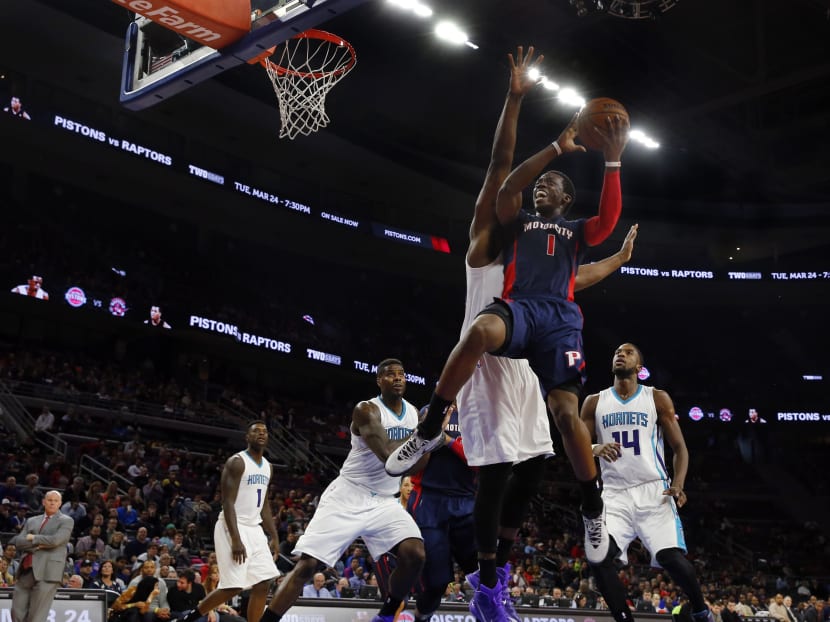Dollars and sense: In the NBA, money is exploding
LAS VEGAS — To understand how the business model of NBA salaries is unlike ever before, consider the cases of Reggie Jackson, Khris Middleton, and DeMarre Carroll.

In this March 8, 2015, file photo, Detroit Pistons guard Reggie Jackson (1) drives to the basket against the Charlotte Hornets in the second half of an NBA basketball game in Auburn Hills, Mich. Photo: AP
LAS VEGAS — To understand how the business model of NBA salaries is unlike ever before, consider the cases of Reggie Jackson, Khris Middleton, and DeMarre Carroll.
They’re not All-Stars.
They’re not household names, either.
Nonetheless, the trio got a combined US$210 million (S$290 million) in deals this summer: Jackson got US$80 million over five years from the Detroit Pistons, Middleton a five-year, $70 million deal to stay with the Milwaukee Bucks, and Carroll a four-year contract worth nearly US$60 million to join the Toronto Raptors.
Only a couple of years ago, such deals would have been considered baffling. These days, they seem quite fair.
“The numbers you hear out there, they seem crazy to think about,” Miami Heat center Hassan Whiteside said.
Thanks to a US$24 billion television deal that kicks in before the 2016-17 season, already skyrocketing salaries will soon reach a new stratosphere. It’s hard to fathom that a league that dealt with serious labor strife four years ago and might be looking at another work stoppage in a couple of years is about to become flush with so much cash.
“One of the things we’re learning is that there is so much that’s unpredictable when the cap is moving so dramatically as it did — as it will next year, and the year after that,” NBA Commissioner Adam Silver said. “We’re continuing to study how our system is absorbing the money.”
Despite all the contract riches, Silver offers a major word of caution — the NBA still insists that plenty of teams are losing money.
“A significant number of teams are continuing to lose money and they continue to lose money because their expenses exceed their revenue,” Silver said.
And yet to many, the riches seem richer than ever. The salary cap for this coming season was supposed to rise considerably to US$67 million; it went even higher, to $70 million. The salary cap for the 2016-17 season might be US$90 million. For the season after that, maybe US$110 million or more.
These days, players that might not have been considered stars are getting what would recently have been star-level deals. John Wall — one of the league’s elite point guards — of the Washington Wizards aired his complaints this week.
“I’m getting the same as Reggie Jackson,” he lamented, as quoted by CSN Washington.
Wall, a two-time All-Star, is going into the second year of a five-year, US$85 million deal. Jackson cashed in after averaging nearly 18 points in 27 games with Detroit last season, a breakout that followed 3 1/2 seasons of largely unheralded work.
“That new (collective bargaining agreement) kicked in at the right time,” Wall said.
Sure, but it seems like all players are reaping benefits. Under the current CBA, player salaries are supposed to make up about 50.4 percent of the league’s basketball-related income. This past season, income grew more than anticipated, and that meant the league wrote a check to the National Basketball Players Association to cover the difference — roughly US$57 million.
Silver thinks that might look like peanuts next year.
“We could be writing a check moving close to half a billion dollars to the players association,” Silver said. “That’s not of course the ideal outcome from our standpoint. ... It’s happened because the revenue we generated was much higher than we had ever modeled. But we’re also learning that when you have all that money coming into the system, team behavior isn’t necessarily predictable either.”
The numbers right now are huge, which is giving some within the game hope that the league and the union — which can opt out of the CBA in two years _ can avoid any more interruptions in play.
Anthony Davis was locked up by the New Orleans Pelicans for US$145 million over the next five years. LeBron James of the Cleveland Cavaliers will make $23 million this season; he could earn more than US$30 million in 2016-17 if he, as would seem likely, opts out once again.
Next summer, Kevin Durant of the Oklahoma City Thunder is the expected headliner of the free-agent class, and his contract could easily set records. Just think what Stephen Curry _ the league MVP and leader of the NBA champion Golden State Warriors — will make when he’s a free agent again in 2017.
Some scoffed when he signed a US$44 million, four-year deal in 2013. Curry seems like the biggest bargain in the game now.
“I’ve never seen anything like it,” New York Knicks general manager Steve Mills said, when asked about how contract values keep soaring. “Obviously, it changes what happens with the league.”
The growth has been steady in recent years, though now the climb seems to be much steeper. In 2011, the average annual value of new free-agent contracts was about US$5 million. So far this year, it’s flirting with the US$10 million mark.
Whiteside will make just under US$1 million this season. Next summer, it wouldn’t be surprising if he landed a deal with a total worth of US$80 million or more.
“Can’t think about it,” Whiteside said. “It’s hard to process. I just worry about what I can control.” AP





